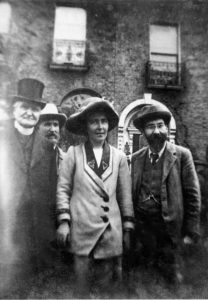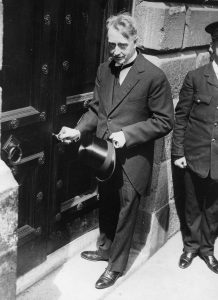Bite-sized History
Published in Issue 5 (September/October 2016), News, Volume 24By Tony Canavan
A different 1916 commemoration
For Carlingford Lough this is the centenary of the collision of the steamships Connemara and Retriever with the loss of 97 lives on the stormy night of 3 November 1916. The Connemara was outbound from Greenore to Holyhead with passengers and livestock. The Retriever was inbound from Garston, near Liverpool, to Newry with a cargo of coal. The night was foul and the seas mountainous, driven by a westerly gale and a fast-ebbing tide. The ships collided in the narrow channel near Haulbowline Lighthouse at the mouth of Carlingford Lough. The Retriever’s unstable cargo had shifted and, driven by a sudden gust, she struck the Connemara amidships. The Connemara sank in seven minutes; the Retriever lasted about fifteen minutes longer. The inrush of water caused the boilers on both ships to explode. Today the ships’ remains lie in only 6m of water. A ceremony is planned in Newry in November to commemorate the tragedy.

Francis Sheehy Skeffington with his wife Hanna in August 1912. (NLI)
A Blue Plaque for Francis Sheehy Skeffington
Francis Sheehy Skeffington, the pacifist and writer, was executed on the order of Captain J.C. Bowen-Colthurst in Portobello Barracks, Rathmines, during the 1916 Rising. He was originally from Ballykinlar, Co. Down, and spent his early years in Bailieborough, Co. Cavan, where his father was a district schools inspector. He added Sheehy to his own name on marrying fellow feminist and campaigner Hanna Sheehy in 1903. To mark the centenary of his death, the Ulster History Circle erected a Blue Plaque in his honour in Bailieborough. The plaque commemorates him as a nationalist, pacifist, feminist and socialist.
Photographic BAP
Photographs of Ireland from the nineteenth century to the present are being digitised by the Belfast Archives Project (BAP) following a grant from the British Heritage Lottery Fund and the Arts Council of Northern Ireland. The images number c. 150,000 and depict scenes from across Ireland. Perhaps most interesting are the photographs depicting events and ordinary life during the years of the Troubles in Belfast, which are a significant part of the collection.
See http://www.belfastarchiveproject.com/ .
Stories from the Somme
The Belfast Somme 100 project has launched its programme to commemorate the centenary of the First World War battle in which the 36th (Ulster) Division played a prominent part. It will run for 141 days, as long as the Somme campaign itself, and will focus on the stories of the ‘ordinary’ soldiers who took part. Through concerts, films, lectures, readings and walks at venues across Northern Ireland and elsewhere, the project is focusing on the personalities and stories associated with the Somme in the context of the social and political history of Ireland then and subsequently of Northern Ireland. It aims to focus on previously overlooked or submerged stories and personal connections that many people in the North still have with this episode.
See http://www.belfastsomme100.com .
Crowning glory
Tullaghoge Fort in County Tyrone, the ancient site where the O’Neill kings of Ulster were installed, is now open to the public. Archaeological digs conducted there in 2014 and 2015 uncovered evidence of a medieval settlement. The site now has interpretative panels and a reconstruction of the stone throne—destroyed by the English in the sixteenth century—on which the kings of Ulster sat. This work at Tullaghoge was carried out to mark the 400th anniversary of the death of Hugh O’Neill, the last Great O’Neill to be inaugurated there.

W.T. Cosgrave officially opening the newly restored GPO in July 1929. (Getty Images)
W.T. Cosgrave Papers
In collaboration with UCD Archives, the W.T. Cosgrave Papers have been fully catalogued and digitised. In December 2014, former taoiseach Liam Cosgrave donated the papers of his late father to the Royal Irish Academy. A collaboration with UCD Archives enabled the arrangement, cataloguing and digitisation of the collection, with digital records now being available at UCD and the Academy. Correspondence forms the bulk of the papers, with many letters relating to Cosgrave’s retirement from politics in 1944. Correspondents include Douglas Hyde, Oliver St John Gogarty, George Sigerson, Frank Duff, Thomas Bodkin, Sir John Lavery, Lord Powerscourt, Seán Lemass, Dan Breen and General Richard Mulcahy.
See https://www.ria.ie/w-t-cosgrave-papers.
A 50th anniversary? … Maybe not
It is generally accepted that in 1966, in response to the ‘over the top’ 50th anniversary commemorations of the 1916 Rising, the notorious loyalist-turned-peacemaker Gusty Spence set up a terrorist organisation called the Ulster Volunteer Force in honour of the original paramilitary force that resisted Home Rule prior to 1914. In 1966 Spence’s UVF murdered three people. The 50th anniversary, however, has given rise to new information that calls into question this account of events. Roy Garland, Spence’s biographer, has revealed that Spence was in fact sworn into an already existing organisation by some older men ‘down the country’, suggesting that the original UVF continued to have a clandestine existence after the establishment of Northern Ireland.
















